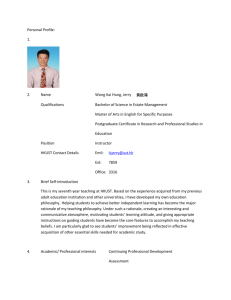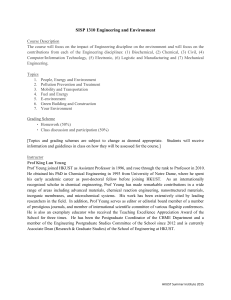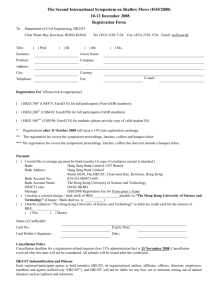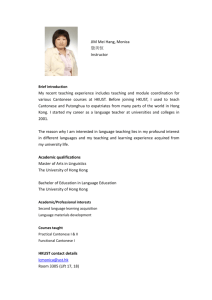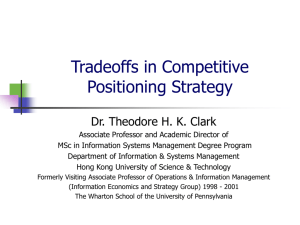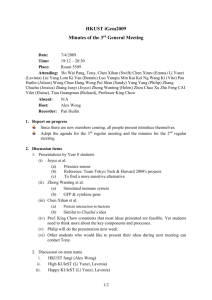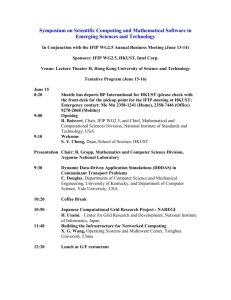Weijia Wen
advertisement
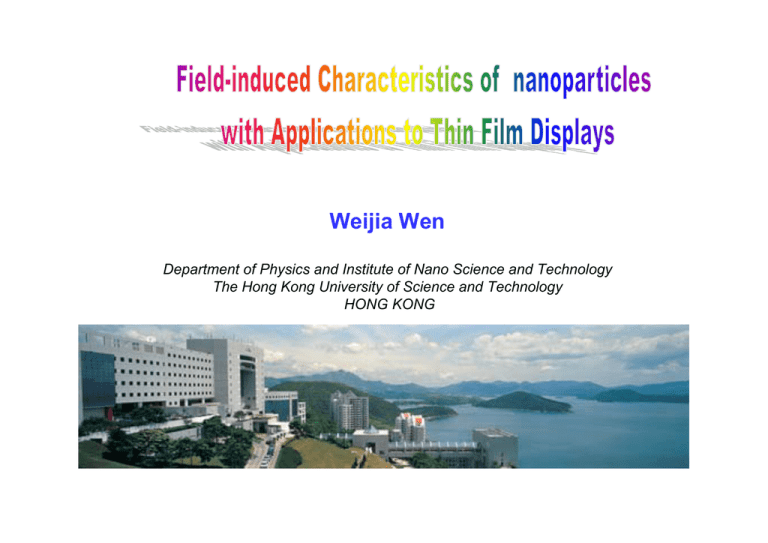
Weijia Wen Department of Physics and Institute of Nano Science and Technology The Hong Kong University of Science and Technology HONG KONG HKUST HKUST Outline: Introduction to Electrorheological effect Display from electrorheological suspension Paperlike thermochromic display HKUST HKUST Electrodes E liquid Dielectric particles ER fluid is a kind of colloid consisting of dielectric particles suspended in a nonconducting liquid. It can change from liquid state to solid state abruptly. dipole-dipole interaction model E + ++ + + p + + + -- -- - + ++ + + + p + + -- -- f∼εE·P/r4=εE2/r4 - Polarized induced by E-field Chain formation Column formation Electrode E>>0 HKUST Structural evolution of ER suspension under an external electric field E=0 Random distribution E E>0 Form chains E>>0 Form columns HKUST E HKUST Display principle HKUST Nanoparticles used for display HKUST b a 100nm 1µm 6 c d Volume % 5 4 3 2 1 0 10 100 P a rtic le S iz e (n m ) 1000 Illustration of the mechanism for the storage mode display left and right panels show the cases without and with applied electric field, respectively Incident HKUST Incident Scattering Reflection ITO Electrodes Dielectric nanoparticles Transmission Top-views of field-induced patterns formed by nanoparticles HKUST Top electrode bottom electrode a E=0 Field area E>>0 b pixel c d Pattern formation with different electrode configurations + electrode + + - nanoparticles - - HKUST Electric field is applied across the top and bottom electrodes Electric field formed by the planar electrodes Optical transmission characteristics of nanoparticle-based suspension at different field strengths 50 300 µm 45 60µm Transmittance (%) 40 ITO 35 E7 30 300µm E8 E6 E5 E4 10 µm 25 E3 20 E2 15 10 E1 5 0 400 E0 500 600 Wavelength(nm) 700 800 HKUST Images viewed through the display panel Viewed through the display panel a Display panel Without electric field b Original color panel With electric field c HKUST Display panels formed with different backgrounds HKUST a c b d luminous powder to the suspension The drawback of nanoparticle-based ER display presented above is the classic tendency of particles to agglomerate together irreversibly, the flocculation effect. Diagram of the synthesis of silica core-gold shell particles reduction Hydrolysis Condensation Surface functionalization Reduction Shell growth Shell growth Results: particle shapes by TEM Dyed particles Gold shell Dispersion in oil 2As 2C Polydimethylsioxane (PDMS)-based conducting composite HKUST (a) Nano or micro-conducting particles 10µm PDMS + conducting particles (b) 1µm SEM pictures of the cured conductive composite and powders: (a) Ag+PDMS (84wt%); (b) C+PDMS 28wt% Electrode fabricated with PDMS/Carbon conducting composite HKUST (b) (a) AZ 4620 Substrate C+PDMS (c) PDMS (d) Hot plate Process flow chart illustrating the patterning of conductive PDMS by soft lithography. (a) Micro-patterning of the conductive PDMS, (b) –(d) SEM pictures showing the various fabricated conductive patterns. Electrode fabricated with PDMS/Silver conducting composite HKUST 100μm (d) (f) silver powder (e) Silver +PDMS Micro-heater from PDMS conducting composite HKUST Schematic illustration of the micro-heater. The three-dimensional helicalpatterned structure is made from silver micro-particles-PDMS composite. Inset: a SEM picture of the micro-heater whose line width is 25 Temperature of the micro-heater’s central heating part plotted as a function of the input voltage. HKUST o Temperature (C ) 300 250 200 150 100 50 0 0.5 mm 0.0 0.5 1.0 1.5 2.0 2.5 Voltage (V) The two insets are IR pictures showing the thermal distributions at specific applied voltages. The bright spot on the right panel is a high temperature region with a temperature of ~250 0C Response time Time dependent temperature variations of the micro-heater square pulse 240 V=2.5v o Temperature (C ) 270 210 180 V=2.0v 150 V=1.5v 120 90 V=1.0v 60 V=0.5v 30 0 20 40 60 80 100 120 140 160 Time (s) The right inset tabulates the temperature rise and decay times, defined at points where the temperature is 80% of the stabilized value. HKUST Integration of multiple micro-heaters to form a thermal display HKUST (a) (b) display cell electrode (b) shows the infrared images of the digits are displayed, demonstrating the ease and flexibility of operations. Fabrication of thermochromic composite HKUST thermochromic nanopowder + PDMS cured thermochromic thin film liquid-like composite reeled film Fabrication processing for paperlike thermochromic display HKUST Thermochromic composite PDMS + Ag composite AZ4620 substrate Hot plate Structure of thermochromic thin film display 22mm HKUST groove thermochromic composite V top view silver-PDMS composite I bottom view HKUST Display panel with flexible character Image appears when power turns on The display is wrapped on a column HKUST (b) (a) curved film voltage off voltage on (a) shows the display film when no input signal is applied, (b) shows the logo image to be correctly displayed when a voltage heating pulse train is applied Display degree plotted as a function of applied voltage HKUST display degree (%) (b) 120 100 (c) 6V 8V 10V 12V 14V voltage off 80 60 (a) 40 20 0 2 4 6 8 10 12 14 16 18 20 time (s) The five curves on the left correspond to a step function voltage of various height, while the one on the right corresponds to what happens after the voltage is turned off. The insets show the logo images at various display degrees. The image in inset C is blurred due to overheating Power consumption of the display under different t/T ratios of the heating pulse train. HKUST 0.19 power (w) 0.18 0.17 0.16 0.15 0.14 0.13 0.12 0.0 0.1 0.2 0.3 t/T 0.4 0.5 The duty cycle is fixed at 50Hz. The table gives the best voltage values (for achieving an accurate image) associated with the various values of t/T ratio. HKUST
